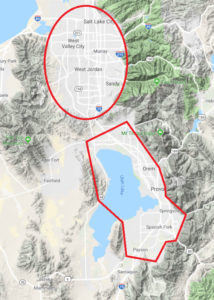See also “Utah regulates the use of wood burning stoves with no-burn days”
Matt Owens doubled over and felt his chest tighten as he struggled to take a deep breath. His airways, constricted by contracting muscles around his lungs, were a fraction of their normal size, causing shortness of breath, dizziness and coughing.
Even though Owens, who was a 2108 first-team All-American on the BYU track team, was in incredible physical shape, he was experiencing something endurance athletes dread: an asthma attack.

Owens did not always have asthma but said vigorous exercise in polluted Utah air induced the condition.
“I first got diagnosed with sports-induced asthma because the air quality made it hard for me to breathe while I was running,” Owens said. “I had to start using an inhaler and purposely focus on running inside when the air was really bad.”
Owens manages to cope fairly well and has big goals for the upcoming track season, but asthma is only one of the many health issues faced by those exposed to polluted air.
Economics professor Arden Pope III is renowned for his extensive research on air pollution and has linked pollution to numerous health issues.
“(Air pollution) contributes to everything from lung cancer to birth outcomes,” Pope said. “Mothers that breathe bad air during pregnancy even have a higher risk of early term birth and low birth weight.”
The valleys along the Wasatch Front have long posed a problem for air pollution and there is a lot of information to consider when evaluating the Utah air problem.
What is most dangerous about the air?
Donna Spangler, communications director at the Utah Department of Environmental Quality, said Utahns should be most worried about breathing in particles created by combustion, mainly coming from automobiles.
“When you breathe in these small particles, you’re breathing in microscopic soot that can get lodged in your lungs, and it’s really difficult to expel,” Spangler said. “If you have a prolonged exposure to these particulates over time, it can cause lung inflammation which can lead to all kinds of health issues.”
The Department of Environmental Quality defines particulate matter (commonly referred to as PM) as a complex airborne mixture of solid particles and liquid droplets.
There are two categories of particulate matter based on diameter: PM2.5, which is all particles with a diameter smaller than 2.5 micrometers — also called fine particles — and PM10, particles with a diameter between 2.5 and 10 micrometers. The average human hair is approximately 70 micrometers in diameter.
Pope posits that almost all particulate matter comes from combustion of some type — whether it be refineries, smelting or even just a fire coming from a wood stove — but Pope said the worst kinds of particulate matter come from fossil fuels.
“The complex mixture from burning fossil fuels like coal and diesel is about as bad as it gets,” Pope said. “It has a huge impact on our respiratory health and cardiovascular health.”
What makes the Wasatch Front so bad?

The valleys along the Wasatch Front have a mix of characteristics Spangler said create a perfect storm for pollution.
“Our valleys are surrounded by mountains, so a lot of the pollution that we get from tailpipes on vehicles gets trapped beneath a layer of warm air,” Spangler said. “Whenever you have mountains surrounding a city, the valley will get filled with pollution if there isn’t a pressure system to get circulation.”
Temperature inversions can make the air especially dangerous in Utah, and the state has a measuring system to warn people when it’s risky to be outside.
There were 27 “red” air quality days in Salt Lake City between November 2017 and February 2018 when air was labeled “unhealthy.” On red days, the Utah Department of Environmental Quality advises children, older adults, people with lung disease and people who are active outdoors to stay indoors and reduce physical exertion.
Breathing in Utah is more difficult than coastal cities due to elevation. With an elevation of 4,550 feet above sea level, the thinness of the oxygen in Provo presents a challenge for any cardiovascular activity to begin with, but particulate matter in the air makes heavy breathing go from exhausting to dangerous.
Concentrated population also plays a big role in the Utah and Salt Lake Valley air pollution problems. With 55 percent of the entire state’s population residing in Utah and Salt Lake counties, thousands of vehicle tailpipes produce the combustion-based particles Pope warned could be deadly.
What health issues are correlated with breathing bad air?
Pope said although most people think of respiratory issues being linked to breathing in bad air, the bigger problem is cardiovascular issues.
“It turns out that cigarette smoke is the same (as air pollution). More people die of cardiovascular disease from smoking than from lung disease,” Pope said. “Secondhand smoke impacts cardiovascular disease and so does air pollution.”
In addition to respiratory and cardiovascular issues, Pope’s studies have found evidence that air pollution contributes to mental health and cognitive issues. Pope also noted that he saw more ischemic strokes in people who have been exposed to air pollution for long periods of time.
The ultimate health effect is premature death. In December 2017, Harvard released findings from a study which imply that air pollution has a linear correlation with mortality rate across the U.S.
The research, which took place over a 13-year period, states not just the elderly were at higher risk of premature death, but many minority groups were affected more heavily due to lack of access to proper care.
“Women and nonwhites also faced a mortality risk that was 25 percent higher than those who were male or white,” the study states. “Poverty, unhealthy lifestyle or poor access to healthcare may play a role in such disparities, the researchers speculated.”
What is being done to fix the problem?
Federal and local governments have made efforts to clean up the air through regulation.
The Clean Air Act of 1970 was a big step toward mandating individuals and businesses to take responsibility for their pollution. Pope said America is better off now than prior to government involvement.
“Our air quality has improved in the U.S. We have gotten quite a bit better since the 1970s,” Pope said. “The Clean Air Act was propagated in 1970 and there have been several amendments to the clean air act since, but we have seen a lot of clean up since then in the United States.”
Local government plays a big part in regulating specific areas such as the Wasatch Front. The state of Utah has an Air Quality Board, which Spangler said does a good job of keeping local air clean.
“The Air Quality Board will pass rules and put in place many different kinds of things that have impacts on small businesses, consumer products and things like that,” Spangler said. “There are about 30 rules that have been put in place over the last several years which have required businesses to install the best available technology to reduce the emissions.”
On a smaller scale, individual counties monitor things like vehicle emissions and enforce smog testing for vehicles in order for them to be registered.
“Things have gotten better,” Pope said. “Not as much better as we would like, but part of the reason is because of the growth — the amount of cars and homes have been growing. Our cars are cleaner and our heating is cleaner, less people are using wood and coal, but there are more people, so it’s like we are treading water.”
How do government regulations affect the economy?
Government regulations that restrict businesses can be assumed to slow growth, but in the case of clean air, Pope suggests otherwise.
“Since 1970 with the establishment of the Clean Air Act, we have reduced our emissions of air pollutions in the aggregate by 70 percent,” Pope said. “In that same time frame our GDP has gone up by 250 percent.”
Spangler said making an effort to clean Utah’s air actually improves the economy.
“Bad air has an impact on the economy,” Spangler said. “People don’t want to move to a state that is seen as having these really horrible periods of pollution.”
Pope, who specializes in economics, said there are economic ramifications to regulating air quality. “I can find very little evidence that in the aggregate our efforts to improve air quality have done anything but helped us economically,” he said.
Podcast by Jefferson Jarvis




